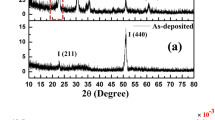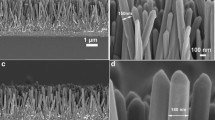Abstract
Coaxial TiO2/In2O3 nanowire (NW) assembly, TiO2 NW and In2O3 NW were synthesized incorporating glancing angle deposition technique inside electron beam evaporator and their structural and optical properties were analyzed. The field emission scanning electron microscopy and transmission electron microscopy confirmed the growth of TiO2/In2O3 NW. X-ray diffraction confirmed the polycrystalline nature of the deposited TiO2/In2O3 NW structure. The surface roughness was 2.12 nm, 6 nm and 6.35 nm for TiO2 NW, In2O3 NW and TiO2/In2O3 NW, respectively using atomic force microscope. The TiO2/In2O3 NW, bare TiO2 NW and In2O3 NW showed water contact angle (CA) of 129°, 68° and 123°, respectively. On exposure to UV light illumination, the surface CA of coaxial TiO2/In2O3 NW, TiO2 NW and In2O3 NW changed to nearly 10°, 30° and 71°, respectively in 1 h. TiO2/In2O3 NW, TiO2 NW and In2O3 NW CAs changed with wettability transition rate of 1.2 × 10−3 degree−1 min−1, 3.2 × 10−4 degree−1 min−1 and 9.2 × 10−5 degree−1 min−1, respectively. There is improvement in photo-induced wettability switching properties of coaxial TiO2/In2O3 NW compared to TiO2 NW and In2O3 NW. This improvement is due to the interfacial surface morphology modification between TiO2 and In2O3 and efficient interaction of separated photogenerated charge carriers with water molecules to adsorb on the surface. On account of these, the change in wettability of heterostructure surface on interaction with UV light can give prospective applications in smart films as antifogging and self-cleaning surfaces.









Similar content being viewed by others
References
Asahi R, Morikawa T, Ohwaki T, Aoki K, Taga Y (2001) Visible-light photocatalysis in nitrogen-doped titanium oxides. Science 293:269–271. https://doi.org/10.1126/science.1061051
Cassie ABD, Baxter S (1944) Wettability of porous surfaces. Trans Faraday Soc 40:546–551. https://doi.org/10.1039/TF9444000546
Chaguetmi S, Mammeri F, Nowak S, Decorse P, Lecoq H, Gaceur M, Naceur JB (2013) Photocatalytic activity of TiO2 nanofibers sensitized with ZnS quantum dots. RSC Adv 3:2572–2580. https://doi.org/10.1039/C2RA21684A
Chang M, Song Y, Sheng HZY, Zheng K, Zhou X, Zou H (2015) Hydrothermal assisted sol-gel synthesis and multisite luminescent properties of anatase TiO2:Eu3+ nanorods. RSC Adv 5:59314–59319. https://doi.org/10.1039/C5RA07525D
Chen S, Zhang S, Galluzzi M, Li F, Zhang X, Yang X, Liu X, Cai X, Zhu X, Du B, Li J, Huang P (2019) Insight into multifunctional polyester fabrics finished by one-step ecofriendly strategy. Chem Eng J 358:634–642. https://doi.org/10.1016/j.cej.2018.10.070
Deng S, Verbruggen SW, He Z, Cott DJ, Vereecken PM, Martens JA, Bals S, Lenaerts S, Detavernier C (2014) Atomic layer deposition-based synthesis of photoactive TiO2 nanoparticle chains by using carbon nanotubes as sacrificial templates. RSC Adv 4:11648–11653. https://doi.org/10.1039/C3RA42928H
Du Y, Huang Z, Wub S, Xiong K, Zhang X, Zheng B, Nadimicherla R, Fua R, Wu D (2018) Preparation of versatile yolk-shell nanoparticles with a precious metal yolk and a microporous polymer shell for high-performance catalysts and antibacterial agents. Polymer 137:195–200. https://doi.org/10.1016/j.polymer.2017.12.069
Fujishima A, Zhang X, Tryk DA (2008) TiO2 photocatalysis and related surface phenomena. Surf Sci Rep 6:515–582. https://doi.org/10.1016/j.surfrep.2008.10.001
Ganesh VA, Nair AS, Raut HK, Walsh TM, Ramakrishna S (2012) Photocatalytic superhydrophilic TiO2 coating on glass by electrospinning. RSC Adv 2:2067–2072. https://doi.org/10.1039/C2RA00921H
Heng H, Gan Q, Menga P, Liu X (2016) H3PW12O40/TiO2–In2O3: a visible light driven type II heterojunction photocatalyst for the photocatalytic degradation of imidacloprid. RSC Adv 6:73301–73307. https://doi.org/10.1016/j.jallcom.2016.11.116
Kenanakis G, Vernardou D, Katsarakis N (2012) Light-induced self-cleaning properties of ZnO nanowires grown at low temperatures. Appl Catal A Gen 411:7–14. https://doi.org/10.1016/j.apcata.2011.09.041
Leng K, Mai W, Zhang X, Liu R, Lin X, Huang J, Lou H, Xie Y, Fu R, Wu D (2018) Construction of functional nanonetwork-structured carbon nitride with Au nanoparticle yolks for highly efficient photocatalytic applications. Chem Commun 54:7159–7162. https://doi.org/10.1039/C8CC03095B
Miyauchi M, Nakajima A, Watanabe T, Hashimoto K (2002) Photocatalysis and photoinduced hydrophilicity of various metal oxide thin films. Chem Mater 14:2812–2816. https://doi.org/10.1021/cm020076p
Mondal A, Shougaijam B, Goswami T, Dhar JC, Singh NK, Choudhury S, Chattopadhay KK (2014) Structural and optical properties of glancing angle deposited In2O3 columnar arrays and Si/In2O3 photodetector. Appl Phys A 115:353–358. https://doi.org/10.1007/s00339-013-7835-8
Mukherjee S, Gall D (2012) Structure zone model for extreme shadowing conditions. Thin Solid Films 527:158–163. https://doi.org/10.1016/j.tsf.2012.11.007
Noh SI, Bae K-N, Ahn H-J, Seong T-Y (2013) Improved efficiency of dye-sensitized solar cells through fluorine-doped TiO2 blocking layer. Ceram Int 39:8097–8101. https://doi.org/10.1016/j.ceramint.2013.03.082
Park S, Kim S, Sun G-J, Lee C (2015) Synthesis, structure, and ethanol gas sensing properties of In2O3 nanorods decorated with Bi2O3 nanoparticles interfaces. ACS Appl Mater 7:8138–8146. https://doi.org/10.1021/acsami.5b00972
Peng XS, Wang YW, Zhang J, Wang XF, Zhao LX, Meng GW, Zhang LD (2002) Large-scale synthesis of In2O3 nanowires. Appl Phys A 74:437–439. https://doi.org/10.1007/s003390101037
Powell MJ, Quesada-Cabrera R, Taylor A, Teixeira D, Papakonstantinou I, Palgrave RG, Sankar G et al (2016) Intelligent multifunctional VO2/SiO2/TiO2 coatings for self-cleaning, energy-saving window panels. Chem Mater 28:1369–1376. https://doi.org/10.1021/acs.chemmater.5b04419
Purkayastha DD, Pandeeswari R, Madhurima V, Krishna MG (2013) Metal buffer layer mediated wettability of nanostructured TiO2 films. Mater Lett 92:151–153. https://doi.org/10.1016/j.matlet.2012.10.070
Rajeshwar K, Osugi ME, Chanmaneec W, Chenthamarakshana CR, Zanoni MVB, Kajitvichyanukul P, Krishna-Ayer R (2008) Heterogeneous photocatalytic treatment of organic dyes in air and aqueous media. Photochem Photobiol C 9:171–192. https://doi.org/10.1016/j.jphotochemrev.2008.09.001
Selim MS, El-Safty SA, El-Sockary MA, Hashem AI, AboElenien OM, El-Saeed AM, Fatthallah NA (2016) Smart photo-induced silicone/TiO2 nanocomposites with dominant [110] exposed surfaces for self-cleaning foul-release coatings of ship hulls. Mater Des 101:218–225. https://doi.org/10.1016/j.matdes.2016.03.124
Su Q, Lu Y, Liu S, Zhang X, Lin Y, Fu R, Wu D (2018) Nano network-structured yolk-shell FeS2@C as high-performance cathode materials for Li-ion batteries. Carbon 140:433–440. https://doi.org/10.1016/j.carbon.2018.08.049
Talinungsang NP, Purkayastha DD, Krishna MG (2018) Dopant controlled photoinduced hydrophilicity and photocatalytic activity of SnO2 thin films. Appl Surf Sci 447:724–731. https://doi.org/10.1016/j.apsusc.2018.04.028
Tonooka K, Kikuchi N (2013) Super-hydrophilic and solar-heat-reflective coatings for smart windows. Thin Solid Films 532:147–150. https://doi.org/10.1016/j.tsf.2012.11.148
Top I, Binions R, Warwick MEA, Dunnill CW, Holdynski M, Abrahams I (2018) VO2/TiO2 bilayer films for energy efficient windows with multifunctional properties. J Mater Chem C 6:4485–4493. https://doi.org/10.1039/C8TC00835C
Weiher RL, Ley RP (1966) Optical properties of indium oxide. J Appl Phys 37:299–302
Xiong J, Das SN, Kim S, Lim J, Choi H, Myoung J-M (2010) Photo-induced hydrophilic properties of reactive RF magnetron sputtered TiO2 thin films. Surf Coat Technol 204:3436–3442. https://doi.org/10.1016/j.surfcoat.2010.04.001
Xu C, Yuan Y, Yuan R, Fu X (2013) Enhanced photocatalytic performances of TiO2-graphene hybrids on nitro-aromatics reduction to amino-aromatics. RSC Adv 3:18002–18008. https://doi.org/10.1039/C3RA42579G
Yasui M, Katagiri K, Yamanaka S, Inumaru K (2012) Molecular selective photocatalytic decomposition of alkyl anilines by crystalline TiO2 particles and their nanocomposites with mesoporous silica. RSC Adv 2:11132–11137. https://doi.org/10.1039/C2RA21009F
Zhou CM, Gall D (2007) Growth competition during glancing angle deposition of nanorod honeycomb arrays. Appl Phys Lett 90:093103. https://doi.org/10.1063/1.2709929
Acknowledgements
The authors are grateful and would like to thank and acknowledge SAIF, NEHU Shillong for TEM analysis, Dr. D. D. Purkayastha of Dept. of Physics NIT Nagaland for CA measurement and UV–visible absorption analysis and NIT Nagaland for financial assistance.
Author information
Authors and Affiliations
Corresponding author
Additional information
Publisher’s Note
Springer Nature remains neutral with regard to jurisdictional claims in published maps and institutional affiliations.
Rights and permissions
About this article
Cite this article
Pooja, P., Choudhuri, B., Saranyan, V. et al. Synthesis of coaxial TiO2/In2O3 nanowire assembly using glancing angle deposition for wettability application. Appl Nanosci 9, 529–537 (2019). https://doi.org/10.1007/s13204-018-0936-0
Received:
Accepted:
Published:
Issue Date:
DOI: https://doi.org/10.1007/s13204-018-0936-0




